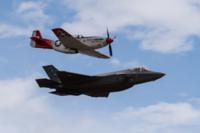The Navy just added its newest Arleigh Burke-class, guided-missile destroyer to the fleet, the USS Jack H. Lucas. It's the first of the Flight III sub class of these surface vessels, which means it features a few upgrades and advancements from previous Arliegh Burke-class destroyers. It's also the first ship named for Jacklyn H. Lucas, who, at age 17, became the Marine Corps' youngest Medal of Honor recipient and the youngest recipient of World War II.
Erik Raven, under secretary of the Navy, delivered the Oct. 7 commissioning ceremony's principal address. Rep. Kathy Castor of Florida's 14th District; Adm. Daryl Caudle, the commander of U.S. Fleet Forces Command; and Sergeant Major of the Marine Corps Carlos Ruiz also delivered remarks. Ruby Lucas, widow of the ship's namesake, was on hand. Though it's the 73rd Arleigh Burke-class, guided-missile destroyer, it's the first warship named for Lucas.
When the Imperial Japanese Navy attacked Pearl Harbor in 1941, Jack Lucas was only 14 years old. He'd spent his early teenage years at the Edwards Military Academy in North Carolina, where he picked up his military discipline and excelled in athletics. Not only was he larger than the average 14-year-old, he looked older, too.

In 1942, Lucas was eager to get into the fight. At 5 feet, 8 inches and 180 pounds, he could pass for an older teen, so he forged his mother's signature and joined the Marine Corps. When he arrived at Parris Island, South Carolina, he found he not only looked the part, but also excelled at combat arms. During basic training, he qualified as a sharpshooter and later became part of a heavy machine-gun crew.
The Marine Corps eventually discovered his true age, and by 1944, Lucas was sent to Hawaii to assume duties as a truck driver. But he hadn't come that far to sit out the war driving trucks, and on Jan. 10, 1945, he rolled up his field dungarees and walked out of camp in Hawaii to stow away aboard the USS Deuel, which was ferrying the 1st Battalion, 26th Marines to Iwo Jima.
On Feb. 8, the day before he would be listed as a deserter, Lucas turned himself in as a stowaway to Capt. Robert Dunlap. His punishment for leaving his post was a demotion, but he would get the chance to fight the Japanese when he was officially transferred to Dunlap's rifle company.
Six days after turning himself in at sea, Lucas celebrated his 17th birthday. Five days after that, he landed on Iwo Jima.
Lucas's four-man fire team was advancing toward an airfield through a ravine on the island when they noticed one of the Japanese defenders' many hidden pillboxes. Taking cover in a trench, they exchanged small arms fire and grenades with 11 Japanese soldiers. The Japanese hurled two grenades into the Marines' trench. When Lucas saw them land in front of his comrades, he shouted, "Grenades," as he pushed a Marine out of the way and threw himself on top of one while scooping up the other.
When the first grenade exploded, it threw Lucas over onto his back and severely wounded the right side of his body, from his right arm down his chest and across his right leg. Luckily, the grenade he'd scooped up in his left hand didn't explode. He was conscious but didn't move, so his fellow Marines believed he was dead and left him to be picked up later. But Lucas didn't die, and the next Marine unit passing through the area called for a corpsman, who treated his wounds, killed an attacking Japanese soldier and carried Lucas to safety.
Lucas would undergo 26 surgeries to repair the damage from the Japanese grenade, but doctors could not remove all the metal from his body. He survived his wounds, and on Oct. 5, 1945, President Harry S. Truman presented Lucas with the Medal of Honor on the South Lawn of the White House.

More than 250 pieces of metal in his body were removed during surgeries. Despite how much was removed, there would be enough shrapnel inside him to set off airport metal detectors for the rest of his life. While Lucas never saw combat again, he would join the Army in 1961, become a paratrooper with the 82nd Airborne and train young troops for combat in Vietnam. He died in 2008 at age 80.
First launched in 1991, the Arleigh Burke-class destroyer is nearly twice as old as Jack Lucas was during the Battle of Iwo Jima in 1945, but its advanced Flight III systems include the latest AN/SPY-6(V)1 air and missile defense radar, the Aegis Baseline 10 combat system and upgrades to its electric power and cooling capacity.
-- Blake Stilwell can be reached at blake.stilwell@military.com. He can also be found on Facebook, X or on LinkedIn.
Want to Learn More About Military Life?
Whether you're thinking of joining the military, looking for post-military careers or keeping up with military life and benefits, Military.com has you covered. Subscribe to Military.com to have military news, updates and resources delivered directly to your inbox.
















